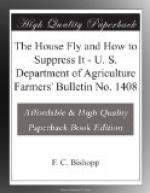[Illustration: FIG. 9. A maggot trap for house-fly control. View showing the concrete basin containing water in which larvae are drowned, and the wooden platform on which manure is heaped. (Hutchison.)]
Experience with this maggot trap clearly indicates that best results can be secured if the manure is compactly heaped on the platform and kept thoroughly moistened. It is best to apply a small amount of water each morning after the stable cleanings have been added to the pile. It should be borne in mind that in order to make this trap a success the platform beneath the pile must be kept comparatively free of accumulations of manure, and moisture applied regularly to drive the maggots out.
COMPACT HEAPING OF MANURE.
Another method of disposing of manure has been recommended by English writers. The manure is built up in a compact rectangular heap, the sides of which are beaten hard with shovels. The ground around the edges of the heap is made smooth and hard and loose straw is placed in small windrows around the manure pile about 1 foot from the edge. The exclusion of the air, together with the high temperature and gases formed by fermentation, tends to make the heap unfavorable for the development of fly larvae. Those which do happen to develop in the surface layers will migrate and pupate in the ring of straw around the heap, where they are destroyed by burning.
GARBAGE DISPOSAL AND TREATMENT OF MISCELLANEOUS BREEDING PLACES.
It is just as true under farm conditions as in cities that breeding places other than horse manure must be attended to. Garbage must be disposed of, hog and poultry manure must be cared for, and especially on dairy farms it is extremely important that every precaution be taken to prevent the contamination of milk by flies.
It is very desirable that all refuse possible, accumulated from cities and towns, be burned. Incineration has been practiced successfully by a number of towns and cities with populations of from 10,000 to 15,000 and over. In larger cities provision should be made for burning carcasses as well as garbage and other refuse. If city and town garbage is sold to hog feeders the municipal authorities should have control of the sanitary conditions about the feeding yards, as there is great danger from fly breeding in such places if not kept clean.




